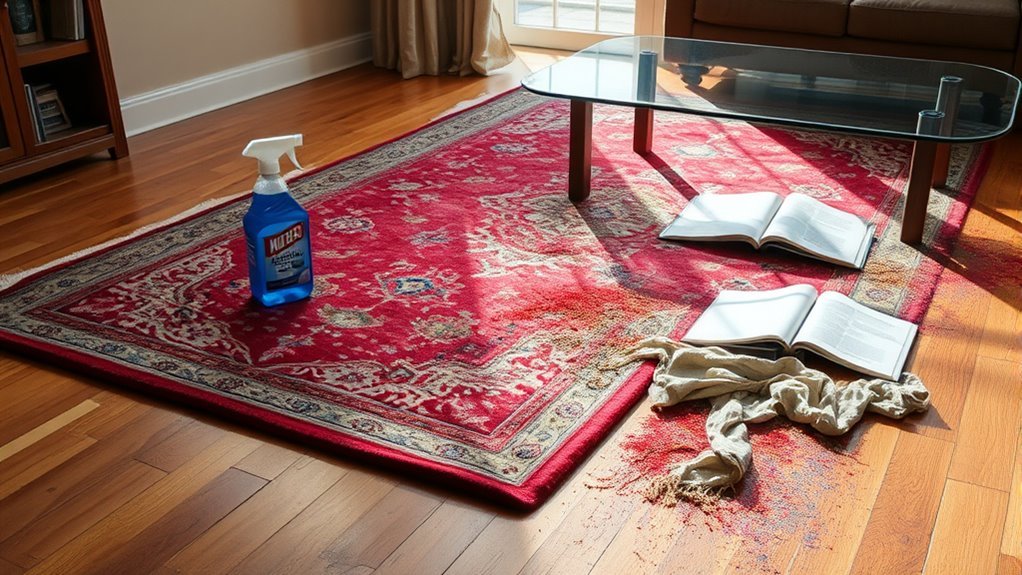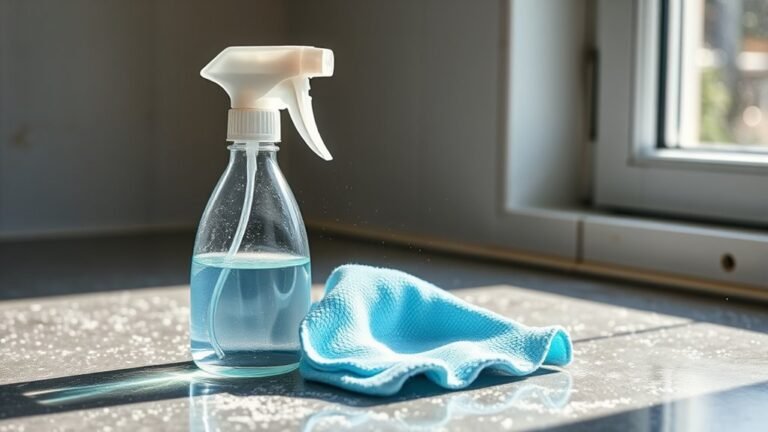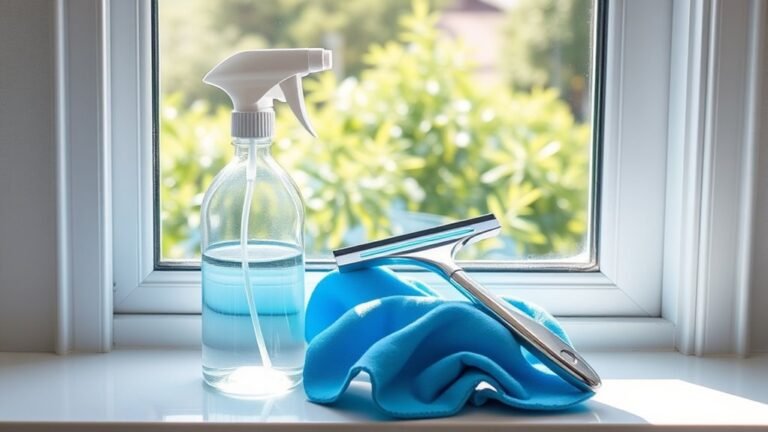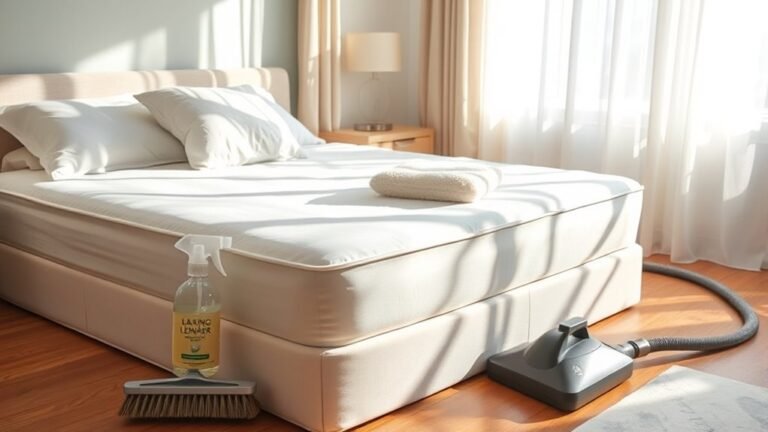Mistakes to Avoid When Cleaning Your Rug
When cleaning your rug, avoid harsh chemicals that can damage fibers and always test products on a small, hidden spot first. Don’t skip regular vacuuming or overwet the rug, as excess moisture leads to mold and fiber weakening. Use the right tools—soft brushes for delicate fibers and adjustable suction vacuums. Never rub stains; blot gently from the outside in. Follow the manufacturer’s care instructions and don’t delay professional cleaning to protect your rug’s longevity. There’s more to guarantee your rug stays pristine and durable.
Using Harsh Chemicals That Damage Fibers

Although it might seem like a quick fix, using harsh chemicals on your rug can severely damage its fibers and shorten its lifespan. You want your rug to last, so prioritizing fiber preservation is key. Instead of reaching for aggressive cleaners, consider chemical alternatives like mild detergents, enzymatic solutions, or natural options such as vinegar and baking soda. These choices clean effectively without breaking down the fibers or causing discoloration. When applying any cleaner, always test a small, inconspicuous area first. This cautious approach protects your rug’s integrity and maintains its vibrant look. By choosing gentle, fiber-friendly products, you gain freedom from constant worry about damage and enjoy a cleaner, longer-lasting rug. Avoid shortcuts; your rug’s health depends on careful, informed care.
Skipping Regular Vacuuming and Maintenance
If you want your rug to maintain its appearance and durability, skipping regular vacuuming and maintenance is a mistake you can’t afford. Rug maintenance isn’t just about occasional deep cleaning; it hinges on consistent care. Vacuum frequency plays an essential role in removing dirt, dust, and debris that embed into fibers, which can cause wear and dullness over time. Ideally, you should vacuum high-traffic areas several times a week and less-used spaces at least once weekly. Neglecting this accelerates fiber breakdown and shortens your rug’s lifespan. Additionally, routine maintenance includes rotating the rug to guarantee even wear and addressing spills promptly. By sticking to these simple, regular steps, you’ll preserve your rug’s vibrancy and texture, granting you freedom from costly repairs and replacements.
Applying Excessive Water During Cleaning

When cleaning your rug, using too much water can lead to prolonged drying times and promote mold or mildew growth. Overwetting often happens when you don’t control the amount of liquid applied or fail to blot excess moisture promptly. To protect your rug’s fibers and backing, it’s vital to apply water sparingly and guarantee thorough drying after cleaning.
Causes of Overwetting
Because rugs absorb water quickly, applying too much during cleaning can easily lead to overwetting. Understanding the causes of overwetting is key to protecting your rug and mastering prevention techniques. Common reasons include:
- Using high-pressure water sprays that saturate fibers excessively
- Over-applying cleaning solutions mixed with water without gauging absorption
- Neglecting to test small areas first, leading to unnecessary water use
- Relying on improper cleaning tools that hold too much liquid
To avoid these pitfalls, measure water carefully and opt for controlled application methods. Remember, your goal is to clean without drenching, preserving the rug’s integrity while maintaining freedom in your cleaning routine. Being mindful of causes of overwetting helps you apply prevention techniques effectively and keep your rug in top condition.
Damage From Excess Water
Although water is essential for cleaning, applying too much can cause serious damage to your rug. Excessive water absorption leads to prolonged moisture retention, which weakens rug fibers and causes warping or shrinking. When your rug holds onto moisture, it becomes a breeding ground for mold and mildew, compromising both the rug’s integrity and your indoor air quality. Overwetting also risks color bleeding, especially in natural dyes, altering your rug’s appearance irreversibly. To protect your rug, avoid saturating it during cleaning, as trapped water beneath the pile is tough to evaporate. Remember, controlling water absorption isn’t just about cleanliness—it’s about preserving your rug’s longevity and ensuring a healthy living space. Avoid excess water to maintain your rug’s beauty and freedom from damage.
Proper Water Usage Tips
If you want to protect your rug from damage, controlling the amount of water you use during cleaning is essential. Applying too much water can lead to prolonged drying times and encourage mold growth. Be mindful of water temperature; lukewarm water is usually best, as hot water might shrink or fade fibers. Avoid rug soaking to prevent structural weakening. Instead, use these practical tips:
- Use a damp cloth or sponge rather than flooding the rug.
- Test water temperature on a small rug section before full cleaning.
- Employ a spray bottle for controlled, even water application.
- Allow the rug to dry completely in a well-ventilated area, avoiding direct sunlight.
These steps help maintain your rug’s integrity and extend its lifespan while giving you freedom from worry.
Ignoring Manufacturer’s Cleaning Instructions

You shouldn’t overlook the manufacturer’s cleaning instructions, as they’re tailored to protect your rug’s materials and finish. Ignoring these guidelines can lead to damage like color fading, fiber weakening, or shrinkage. If the label’s missing or unclear, check the brand’s website or contact customer service to get accurate care directions.
Importance of Label Guidelines
Since every rug is crafted from specific materials requiring unique care, ignoring the manufacturer’s cleaning instructions can easily lead to damage or color fading. Paying close attention to label care and cleaning symbols is essential to maintain your rug’s integrity and appearance. These guidelines are designed to protect your investment by providing:
- Specific temperature limits for washing or spot cleaning
- Recommended cleaning agents or solvents to avoid harsh chemicals
- Instructions on drying methods to prevent shrinkage or distortion
- Warnings against certain cleaning techniques that could harm fibers
Risks of Incorrect Cleaning
Disregarding the manufacturer’s cleaning instructions can lead to serious damage that’s often irreversible. When you use incorrect techniques, you risk harming the rug’s fibers, colors, and overall integrity. Manufacturer guidelines are tailored to protect your rug’s unique materials and construction, so ignoring them can cause fiber damage and reduce its lifespan.
| Risk | Consequence |
|---|---|
| Using harsh chemicals | Fiber weakening and color fade |
| Excessive water | Mold growth and fabric warping |
| Aggressive scrubbing | Fiber breakage and distortion |
To maintain your rug’s freedom in style and durability, always follow instructions closely. This avoids costly repairs or replacements and guarantees your rug remains vibrant and intact for years to come.
How to Find Instructions
Where can you turn if the manufacturer’s cleaning instructions are missing or unclear? Finding manuals or reliable guidance is essential to avoid damaging your rug. Start by exploring online resources tailored to your rug type. Here’s how to proceed:
- Search the brand’s official website for downloadable manuals or FAQs.
- Consult trusted rug care forums or websites with expert advice.
- Use image or model number searches to locate specific cleaning guides.
- Reach out directly to customer service for personalized instructions.
Rubbing Stains Instead of Blotting
One of the most common mistakes people make when dealing with rug stains is rubbing instead of blotting the affected area. Rubbing can push the stain deeper into the rug fibers, making stain removal more difficult and sometimes causing permanent damage. Instead, you should use proper blotting techniques—gently pressing a clean, absorbent cloth or paper towel onto the stain to lift the liquid without spreading it. Blotting helps absorb the stain while minimizing fiber disturbance, preserving your rug’s texture and appearance. Remember to work from the outside of the stain inward to avoid expanding the affected area. By mastering these blotting techniques, you’ll maintain your rug’s freedom from stubborn stains and extend its lifespan, all while avoiding the frustration of worsening damage through rubbing.
Using the Wrong Cleaning Tools for Your Rug Type
Selecting the right cleaning tools for your rug is essential to prevent damage and guarantee effective stain removal. Different rug types require specific tools to maintain their texture and color integrity. Using harsh brushes on delicate fibers or oversized vacuums on shag rugs can lead to irreversible harm. Here’s what you should consider:
Choosing appropriate cleaning tools is crucial to protect your rug’s texture and ensure effective stain removal.
- Choose soft-bristle brushes for delicate rugs like silk or antique wool.
- Opt for a vacuum with adjustable suction for high-pile or shag rugs.
- Use microfiber cloths for gentle blotting on sensitive materials.
- Avoid stiff scrubbers on natural fiber rugs such as jute or sisal.
Neglecting to Test Cleaning Products on a Small Area
How can you be certain a cleaning product won’t damage your rug if you don’t test it first? Skipping cleaning product testing on a small area evaluation risks color fading, fiber damage, or residue buildup. Always apply the cleaner to an inconspicuous spot, wait for it to dry, and observe results before proceeding. This step protects your rug’s integrity and gives you the freedom to clean confidently.
| Schritt | Action | Zweck |
|---|---|---|
| 1. Choose spot | Select hidden corner or edge | Avoid visible damage |
| 2. Apply product | Use recommended amount | Prevent over-saturation |
| 3. Wait & inspect | Let dry completely | Check for discoloration or harm |
| 4. Proceed or adjust | Clean entire rug or try another | Guarantee safe, effective cleaning |
Delaying Professional Cleaning When Needed
Although regular cleaning can keep your rug looking fresh, delaying professional cleaning when needed can cause stubborn stains, deep-set dirt, and fiber damage to worsen over time. You might feel tempted to push back professional rug cleaning, but maintaining the right cleaning frequency is essential for preserving your rug’s integrity. Ignoring timely cleaning can lead to:
Delaying professional rug cleaning allows stains and damage to worsen, compromising your rug’s beauty and durability.
- Permanent discoloration from untreated stains
- Accumulated allergens affecting indoor air quality
- Fiber breakdown resulting in thinning and fraying
- Reduced lifespan, forcing costly replacements sooner
Häufig gestellte Fragen
How Often Should I Rotate My Rug to Prevent Uneven Wear?
To maintain your rug’s appearance and extend its life, you should consider a rug rotation frequency of every three to six months. Regular rotation helps with uneven wear prevention by distributing foot traffic and sunlight exposure evenly across the rug’s surface. This practical habit guarantees no area becomes overly faded or worn, preserving your rug’s beauty and giving you the freedom to enjoy it without worrying about premature damage.
Can Sunlight Damage My Rug’S Colors Over Time?
Think of your rug’s colors as a vibrant sunrise—beautiful but vulnerable. Yes, sunlight can cause fading colors over time, dulling that brilliance you love. The UV rays act like an invisible brush, slowly washing away hues. To keep your rug’s freedom intact, use UV protection like window films or shades, and rotate it regularly. This way, your rug stays lively and bright, preserving its essence for years to come.
What’S the Best Way to Remove Pet Odors From Rugs?
To effectively remove pet odor from your rugs, you’ll want to start with thorough cleaning methods that target both surface and deep-seated smells. Begin by vacuuming to eliminate hair and dander. Then, apply an enzymatic cleaner designed to break down organic residues causing odors. Avoid harsh chemicals that might damage fibers. Let the rug air dry completely in a well-ventilated space. Consistent cleaning keeps your rug fresh and your living space free.
Are Natural Fiber Rugs More Fragile Than Synthetic Ones?
Natural fibers like wool, cotton, or jute tend to be more delicate compared to synthetic ones such as nylon or polyester. When you’re considering durability comparison, natural fibers can be prone to wear, moisture damage, and fading if not cared for properly. You’ll want to handle them gently, avoid harsh chemicals, and spot clean promptly. Synthetic rugs offer more resilience, but if you prefer natural textures, just remember to treat them with extra care to preserve their beauty and longevity.
How Can I Protect My Rug From Insect Infestations?
Imagine your rug as a cozy forest floor, inviting but vulnerable. To protect it from insect infestations, vacuum regularly, removing dirt and eggs hiding in fibers. Use an insect repellent specifically designed for rugs, applying it carefully to avoid damage. Keep your rug dry and well-ventilated, since moisture attracts pests. These steps help maintain its beauty and freedom from unwelcome critters, ensuring your rug stays a safe, vibrant part of your home.






